9 Home Remedies For Pimple Inside The Nose
Simple and effective methods to keep those pesky nose pimples at bay!
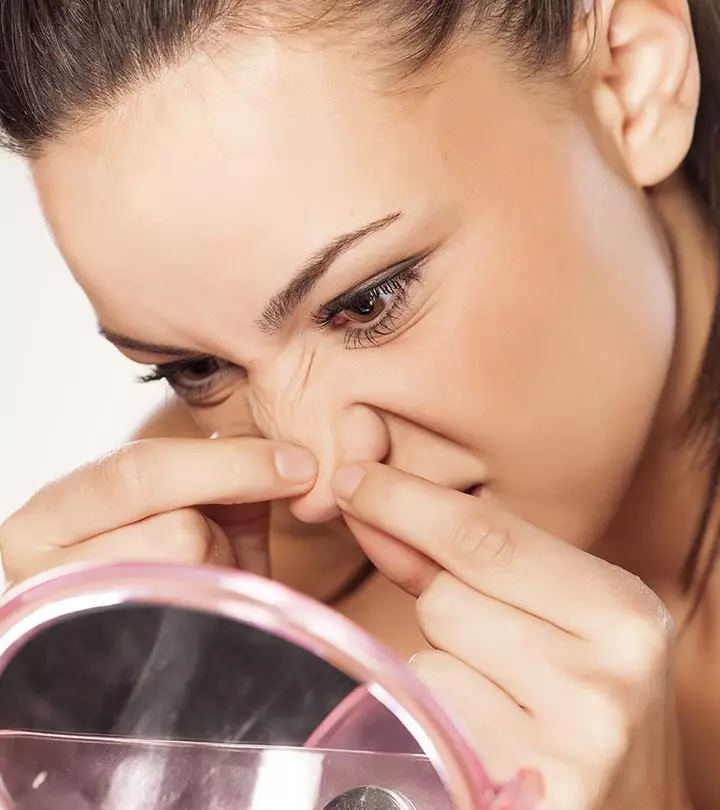
Image: Shutterstock
A pimple inside your nose can be both painful and annoying. If you are dealing with this issue, you are not alone. It is quite common and often caused by a clogged pore. Luckily, there are effective home remedies for pimples inside the nose that you can try to relieve discomfort. These natural solutions can help reduce inflammation and promote healing. But before you dive into remedies, it is important to understand what causes these pimples. Sometimes, they can signal an underlying medical condition that requires attention. In this article, we explore some helpful home remedies, various causes, and symptoms so you can better manage this frustrating issue. Ready to find relief? Scroll down!
In This Article
Home Remedies To Get Rid Of A Pimple Inside The Nose
1. Warm Compress
A warm compress may increase circulation and reduce nasal inflammation in the affected area. Hence, it may help treat a painful pimple in your nose.
You Will Need
A warm compress
What You Have To Do
- Apply a warm compress on the nose.
- Place it there for about 5 minutes and remove it.
- Alternatively, you can also wash the pimple with warm water.
How Often You Should Do This
You can do this 2-3 times a day.
2. Essential Oils
a. Rosemary Oil
Rosemary oil possesses analgesic, antimicrobial, antioxidant, antiseptic, fungicidal, and astringent properties (1). These properties may help heal nasal comedones faster and prevent further breakouts.
You Will Need
- 1-2 drops of rosemary oil
- 5 drops of coconut oil
What You Have To Do
- Mix one to two drops of rosemary oil with any carrier oil like coconut oil.
- Apply the mixture to the affected area.
- Leave it on for 30 minutes before rinsing it off.
- You can also try this remedy as an overnight treatment.
How Often You Should Do This
Do this 2-3 times a day.
b. Tea Tree Oil
Tea tree oil has antimicrobial, anti-inflammatory, and bactericidal properties (2).
A study published in Molecules showed that it had antibacterial efficacy against many strains of gram-negative bacteria that were resistant to multiple drugs as well as methicillin-resistant Staphylococcus aureus.
The maximum inhibitory activity of tea tree oil was against carbapenem-resistant Acinetobacter baumannii, while the lowest inhibitory activity was against methicillin-susceptible and methicillin-resistant Staphylococcus aureus. This suggests that this oil is efficacious at reducing the number of common skin-infecting germs. Acinetobacter baumannii is a common infectious microbe found in open wounds, thus tea tree oil works as an effective antiseptic against it.

Antibacterial Activity Of Tea Tree Oil
Source: High Potency of Melaleuca alternifolia Essential Oil against Multi-Drug Resistant Gram-Negative Bacteria and Methicillin-Resistant Staphylococcus aureusThe components of the oil penetrate deep into skin and support the regeneration of skin damaged by acne-causing bacteria.
You Will Need
- 4 drops of tea tree oil
- 1 teaspoon of coconut oil
What You Have To Do
- Combine four drops of tea tree oil with one teaspoon of coconut oil.
- Apply this mixture to the pimple and leave it on for 20 to 30 minutes.
- Rinse it off with water.
- You can also use this as an overnight treatment.
How Often You Should Do This
Apply tea tree oil 2-3 times daily.
 Quick Tip
Quick Tip3. Neem Oil
Neem
exhibits strong antimicrobial and anti-inflammatory properties (3). These properties of neem may help in combating pimples.
You Will Need
2-3 drops of neem oil
What You Have To Do
- Apply neem oil directly to the pimple with your finger.
- Leave it on for about 30 minutes before rinsing it off.
- You can also leave it on overnight.
How Often You Should Do This
Do this 2-3 times a day.
4. Coconut Oil
Coconut oil is a powerful anti-inflammatory and analgesic agent (4). This may help in reducing the nasal redness and swelling associated with pimples.
You Will Need
A few drops of cold-pressed coconut oil
What You Have To Do
- Apply coconut oil to the pimple inside your nose.
- Allow it to dry on its own.
- Reapply as necessary.
How Often You Should Do This
Do this 2-3 times a day.
5. Lemon
Lemon possesses astringent and antimicrobial properties. It may help in preventing skin infections like acne (5). Lemon also has anti-inflammatory properties (6). This may help in reducing the inflammation inside the nose.
You Will Need
- A few drops of lemon juice
- Water (optional)
What You Have To Do
- Apply freshly squeezed lemon juice to the pimple.
- If you have sensitive skin, mix the lemon extract with an equal volume of water before application.
- Rinse it off after 30 minutes.
How Often You Should Do This
Do this 1-2 times a day.
6. Hydrogen Peroxide
Hydrogen exhibits powerful anti-inflammatory properties (7). Hence, it may speed up the healing of pimples.
You Will Need
- 3% hydrogen peroxide (as required)
- Cotton buds
What You Have To Do
- Soak a cotton bud in 3% hydrogen peroxide solution. Those who have highly sensitive skin may mix hydrogen peroxide with a little water.
- Place the cotton bud on the pimple for a minute.
- Discard the used bud.
- Wash your nose after 20 minutes.
How Often You Should Do This
Do this 2-3 times a day.
7. Apple Cider Vinegar
Apple cider vinegar exhibits anti-inflammatory and antibacterial properties (8). These properties may help in fighting acne-causing bacteria.
You Will Need
- Raw apple cider vinegar (as required)
- A cotton bud
What You Have To Do
- Dip a cotton bud in raw apple cider vinegar.
- Place the bud on the pimple.
- Allow it to work on the pimple for about 30 minutes.
- Rinse it off.
How Often You Should Do This
Do this once a day.
8. Honey
Honey exhibits antibacterial properties that may help fight against Propionibacterium acnes (P. acnes), the bacteria responsible for acne (10). It also possesses anti-inflammatory properties that may help reduce the swelling and redness associated with acne (10). Further, research suggests that honey may be more effective in treating acne than an antibacterial soap (11).
You Will Need
- A few drops of honey
- A clean towel
What You Have To Do
- Take a small amount of honey and apply it directly to the pimple.
- Allow it to work on the pimple for about 15–20 minutes.
- Rinse it off with lukewarm water.
How Often You Should Do This
You can use this remedy thrice a week.
9. Warm Saline Rinse
Research shows that a warm saline rinse may help clean the nasal passages and reduce inflammation (13). This will provide relief from the discomfort or pain of the pimple inside the nose.
You Will Need
- 1 cup of warm water
- ½ teaspoon of salt
What You Have To Do
- Mix the warm water and salt to prepare a saline solution.
- Stand in front of a sink with your head over it. Tilt your head diagonally up a little.
- Gently pour the saline solution into one nostril, such that it drains from the other.
- Repeat with the other nostril.
How Often You Should Do This
You can try this remedy 1-2 times a day.
While natural remedies can help get rid of nasal acne or pimples inside the nose, it is important to understand why these pimples occur in the first place. Keep reading to know more!
What Causes A Pimple Inside The Nose?
There are various reasons a pimple develops inside the nose. In some cases, it may be a result of an underlying infection. One of the most common causes of pimples may be a clogged or blocked skin pore. This clogging may be the result of an accumulation of dead skin cells or oil.
Apart from dead skin cells and oil, open pores may also invite bacteria. This may cause the pores to become inflamed and infected, resulting in acne or pimples. This infection may result in the following:
- Nasal Furuncles And Cellulitis: Nasal furuncles are deeper infections in the nose that occur in the form of boils. This condition is considered to be dangerous as there are chances that it may lead to cellulitis. Cellulitis is an infection that spreads rapidly and can even enter your bloodstream.
- Nasal Vestibulitis: This condition is also referred to as nasal folliculitis. It may result in a single red, inflamed bump or a cluster of red or white bumps at the opening of your nostrils. Staph (Staphylococcus) bacteria are the most common cause of this infection, popularly known as Nasal staph infection.
- Ingrown Hair: Some people try to get rid of their nasal hair. This may cause them to develop ingrown hair – another common cause for pimples to develop inside the nose.
Listed below are the signs and symptoms of a pimple inside your nose.
Signs And Symptoms
- Papules – Small red bumps that are tender to touch
- Whiteheads or clogged (closed) pores
- Pustule – A bump with a little pus at its tip
- Nodules – Large and painful bumps under your skin
- Cystic lesions or pus-filled bumps beneath your skin
- Swelling
- Inflammation and pain
If you notice a bump inside your nose, it is important to distinguish whether it is just a pimple or something else, like a nasal infection or furuncle. This is why you should consult a doctor for a proper diagnosis. Scroll down to learn how your doctor may diagnose the problem.
Diagnosis
A doctor usually performs a physical examination to diagnose a pimple inside the nose. They may examine the area closely to assess the size, location, and severity of the pimple and check for any signs of infection. If necessary, they may also recommend a biopsy or other imaging studies to cross out any underlying risks like nasal tumors. Depending on their findings, the doctor may prescribe topical or oral antibiotics, or suggest other treatment options to manage the condition.
Prevention Tips
- Avoid picking your nose too much.
- Do not blow your nose too hard or too often.
- Increase the intake of vitamin-D rich foods.
- Keep stress under control.
- Wash your face twice daily with a mild cleanser. This removes excess oil, dirt, and bacteria, preventing clogged pores and keeping your skin clear.
- Use less makeup.
- Do not touch your face or nose too often.
- Keep away from the sun.
- Exercise regularly.
 Quick Tip
Quick TipInfographic: Tips To Prevent Pimple Inside Nose
The nose zits can be annoying, painful, and distressing. While natural remedies may provide relief, following simple tips such as eating vitamin D-rich foods and managing your stress effectively can reduce the risk of developing a pimple inside your nose.
Check out the infographic below to know more! Illustration: StyleCraze Design Team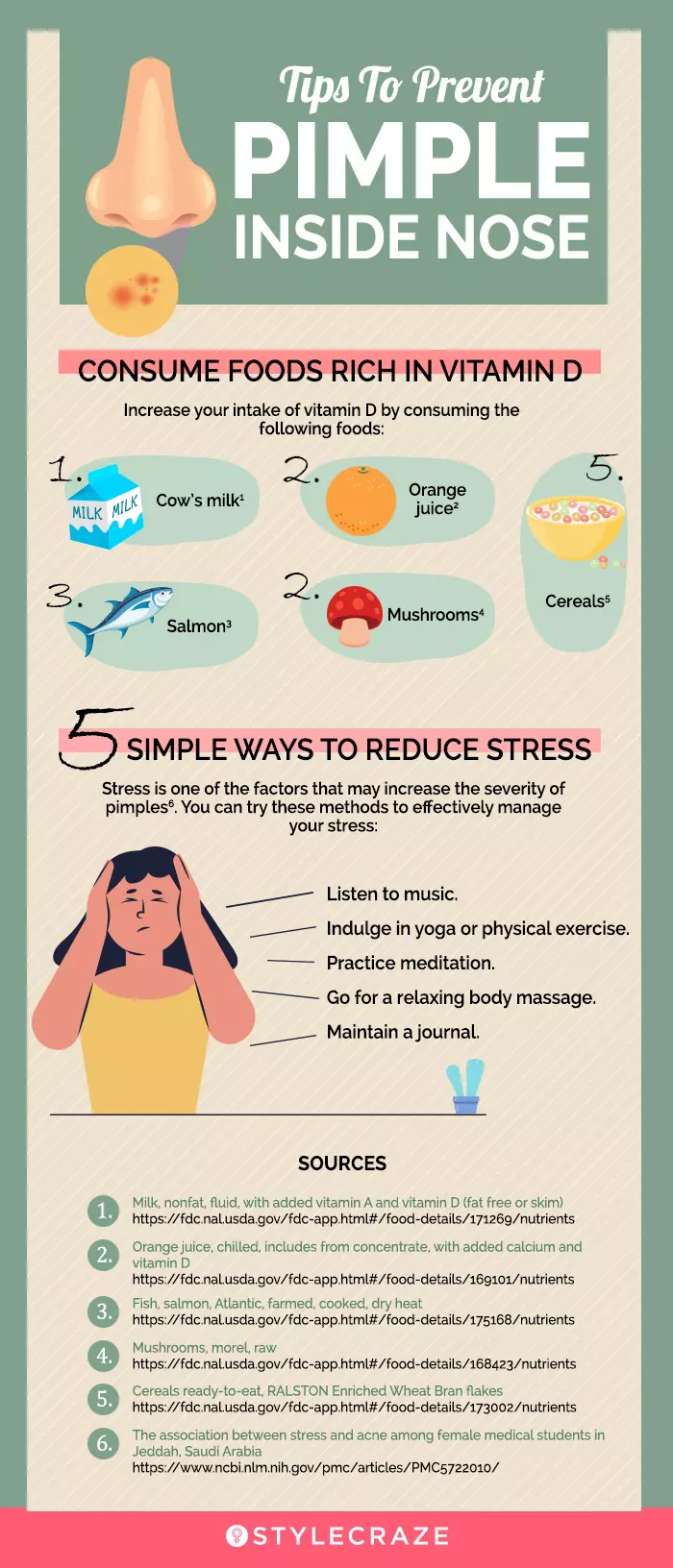
Pimples inside the nose can be annoying and painful. Usually, clogged skin pores may cause this issue. Fortunately, certain home remedies for pimples inside the nose can help you manage them. These remedies involve using warm compresses, and ingredients like essential oils, lemon, hydrogen peroxide, and apple cider vinegar. They are known to reduce the pain and swelling around the pimple. In addition, increasing your intake of foods rich in vitamin C, keeping your stress under control, using less makeup, and washing your face twice a day may help reduce the occurrence of pimples. Also, learning more about how to get rid of pimples in general may help you manage them effectively. However, consult your dermatologist if your pimple doesn’t heal despite using home remedies.
Frequently Asked Questions
When to see a doctor?
If the pimple inside your nose doesn’t heal or gets worse with time, it is best to consult a doctor. This is because, in rare cases, it may lead to infections, which may further lead to a blood clot in the brain as some nerves in the nose are connected to the brain.
Is it safe to pop a pimple inside your nose?
It is not safe to pop a pimple inside the nose as it increases the risk of scarring. However, you can visit a medical salon or dermatologist to get the pimple popped professionally.
How long does it take for a pimple inside the nose to go away?
A pimple without a pus-filled head may heal in two days to a week. The pus-filled pimples may take longer to heal – about a week and a half. If the nasal cysts are deeper and have discharged its content within the skin, it may take up to a month to heal.
Do I need to see a doctor for nasal vestibulitis?
Yes, it is recommended to see a doctor for nasal vestibulitis as infections in the nose can spread and form blood clots, which can be dangerous.
Is it OK to put Vaseline in your nose?
It is not recommended to put Vaseline inside your nose as it poses the risk of traveling to your lungs through the windpipe. A little bit on the lining of your nose may be acceptable as long as it is not done frequently.
Key Takeaways
- Pimples inside the nose may happen due to Infections, blocked pores, or ingrown hair.
- Inflammation, swelling, and redness in the area are some of the symptoms of such pimples.
- Oils such as neem oil and rosemary oil may help prevent pimples inside the nose as they have antimicrobial properties.
- Include Vitamin D-rich foods in your diet.
- Try not to touch or itch your face and nose too often.
Illustration: Home Remedies For Pimple Inside The Nose & Prevention Tips

Image: Dall·E/StyleCraze Design Team
Having a pimple inside your nose can be annoying. Learn the best ways to get rid of it quickly and effectively with this video! Check it out!
References
Articles on StyleCraze are backed by verified information from peer-reviewed and academic research papers, reputed organizations, research institutions, and medical associations to ensure accuracy and relevance. Read our editorial policy to learn more.
- de Oliveira, Jonatas Rafael et al. “Rosmarinus officinalis L. (rosemary) as therapeutic and prophylactic agent.” Journal of biomedical science vol. 26,1 5.
https://www.ncbi.nlm.nih.gov/pmc/articles/PMC6325740/ - Carson, C F et al. “Melaleuca alternifolia (Tea Tree) oil: a review of antimicrobial and other medicinal properties.” Clinical microbiology reviews vol. 19,1 (2006): 50-62.
https://www.ncbi.nlm.nih.gov/pmc/articles/PMC1360273/ - Alzohairy, Mohammad A. “Therapeutics Role of Azadirachta indica (Neem) and Their Active Constituents in Diseases Prevention and Treatment.” Evidence-based complementary and alternative medicine : eCAM vol. 2016 (2016): 7382506.
https://www.ncbi.nlm.nih.gov/pmc/articles/PMC4791507/ - Intahphuak, S et al. “Anti-inflammatory, analgesic, and antipyretic activities of virgin coconut oil.” Pharmaceutical biology vol. 48,2 (2010): 151-7.
https://pubmed.ncbi.nlm.nih.gov/20645831/ - Fox, Lizelle et al. “Treatment Modalities for Acne.” Molecules (Basel, Switzerland) vol. 21,8 1063.
https://www.ncbi.nlm.nih.gov/pmc/articles/PMC6273829/ - Galati, Enza Maria et al. “Anti-inflammatory effect of lemon mucilage: in vivo and in vitro studies.” Immunopharmacology and immunotoxicology vol. 27,4 (2005): 661-70.
https://pubmed.ncbi.nlm.nih.gov/16435583/ - Milani, Massimo et al. “Efficacy and safety of stabilised hydrogen peroxide cream (Crystacide) in mild-to-moderate acne vulgaris: a randomised, controlled trial versus benzoyl peroxide gel.” Current medical research and opinion vol. 19,2 (2003): 135-8.
https://pubmed.ncbi.nlm.nih.gov/12740158/ - Yagnik, Darshna et al. “Antimicrobial activity of apple cider vinegar against Escherichia coli, Staphylococcus aureus and Candida albicans; downregulating cytokine and microbial protein expression.” Scientific reports vol. 8,1 1732.
https://www.ncbi.nlm.nih.gov/pmc/articles/PMC5788933/ - Mohammed H. Taleb et al. “Origanum vulgare L. Essential Oil as a Potential Anti-Acne Topical Nanoemulsion—In Vitro and In Vivo Study”.
https://www.ncbi.nlm.nih.gov/pmc/articles/PMC6225355/ - Wu, Q. “Antimicrobial effect of Manuka honey and Kanuka honey alone and in combination with the bioactives against the growth of Propionibacterium acnes.” Massy University, Albany, New Zealand.
https://core.ac.uk/download/pdf/148637748.pdf - Burlando, Bruno et al. “Honey: A Therapeutic Agent for Disorders of the Skin” US National Library of Medicine.
https://www.ncbi.nlm.nih.gov/pmc/articles/PMC5661189/ - Nicola Principi and Susanna Esposito. “Nasal Irrigation: An Imprecisely Defined Medical Procedure” International Journal of Environmental Research and Public Health
https://www.ncbi.nlm.nih.gov/pmc/articles/PMC5451967/
Read full bio of Dr. Priya Gill
Read full bio of Shaheen Naser
Read full bio of Anjali Sayee
Read full bio of Swathi E





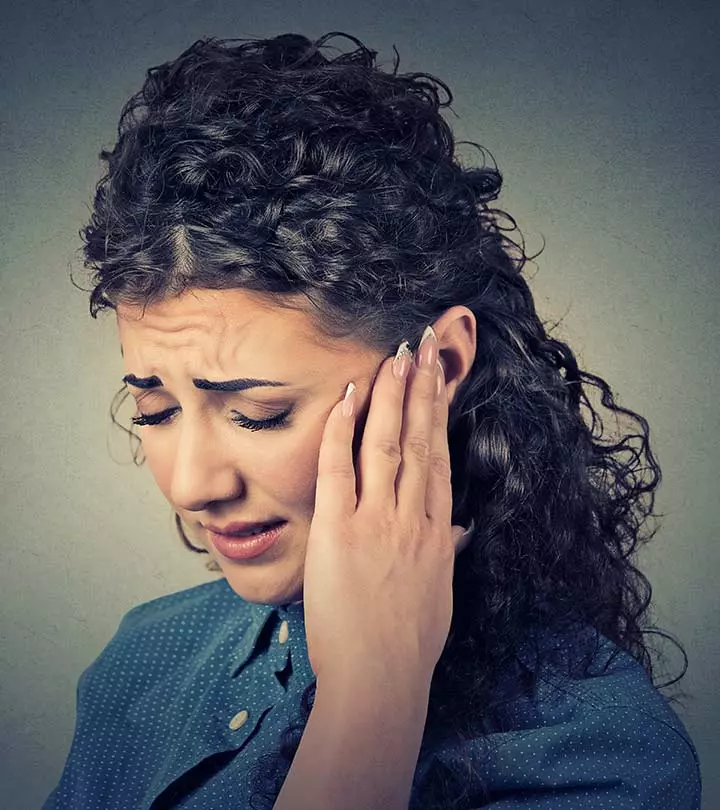
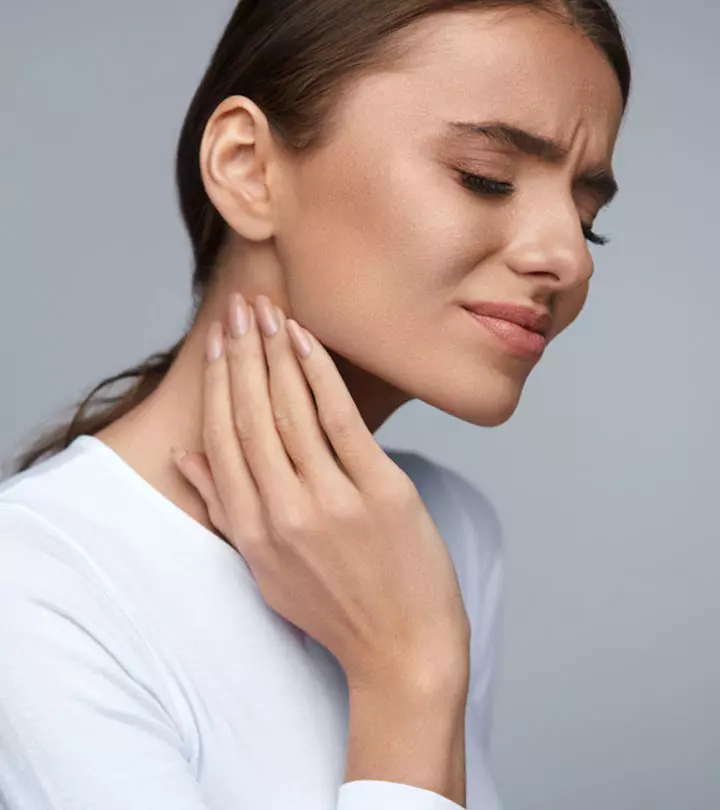
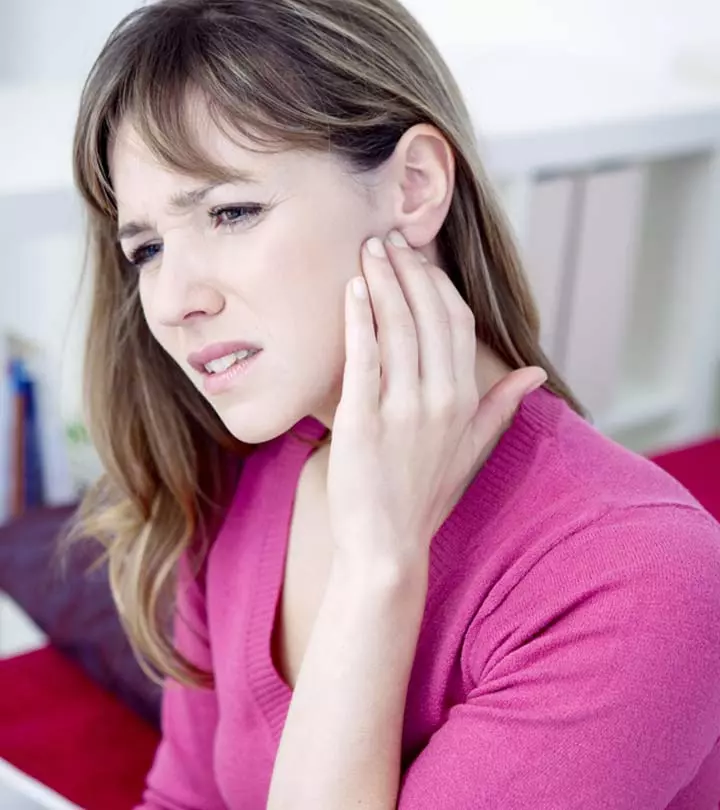
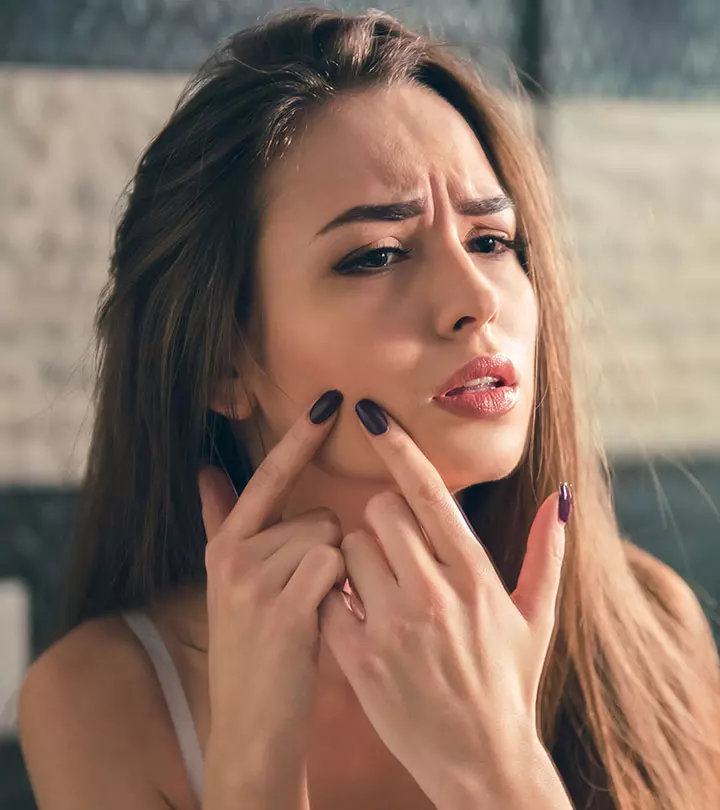


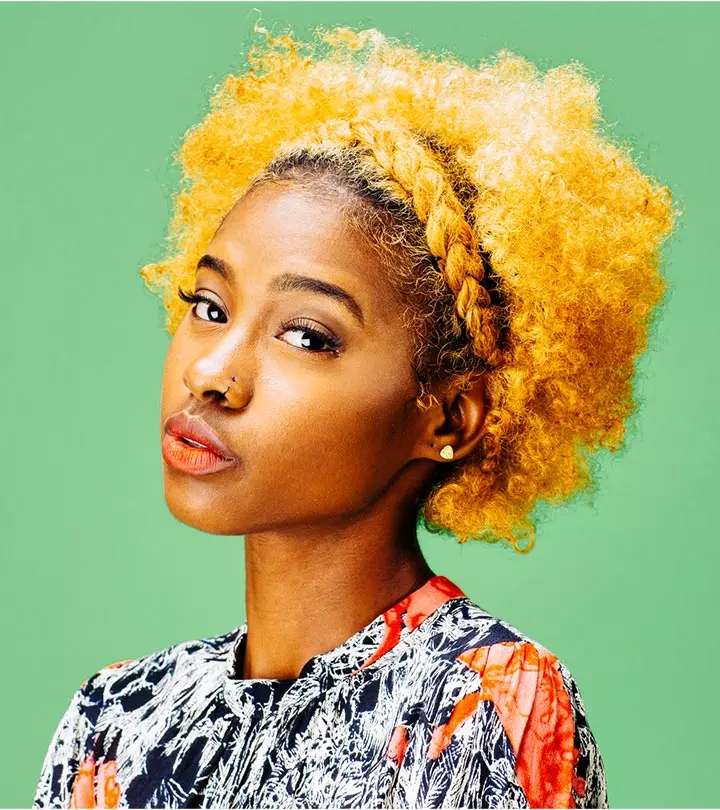
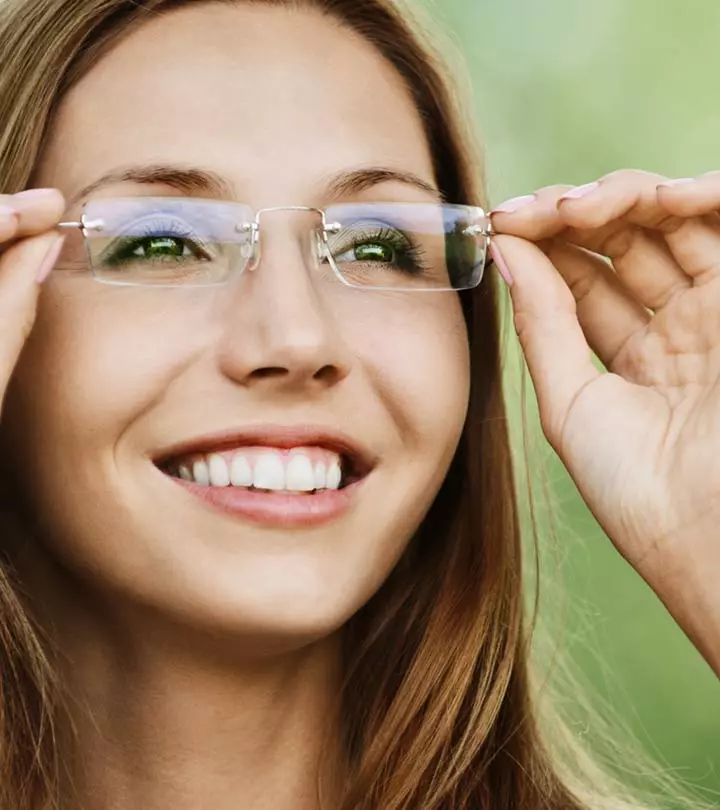

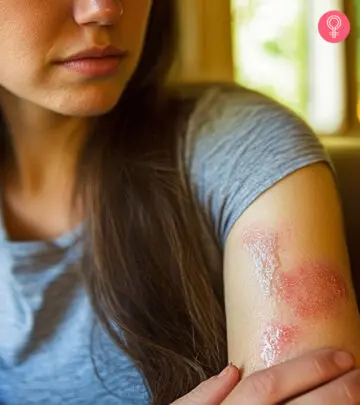
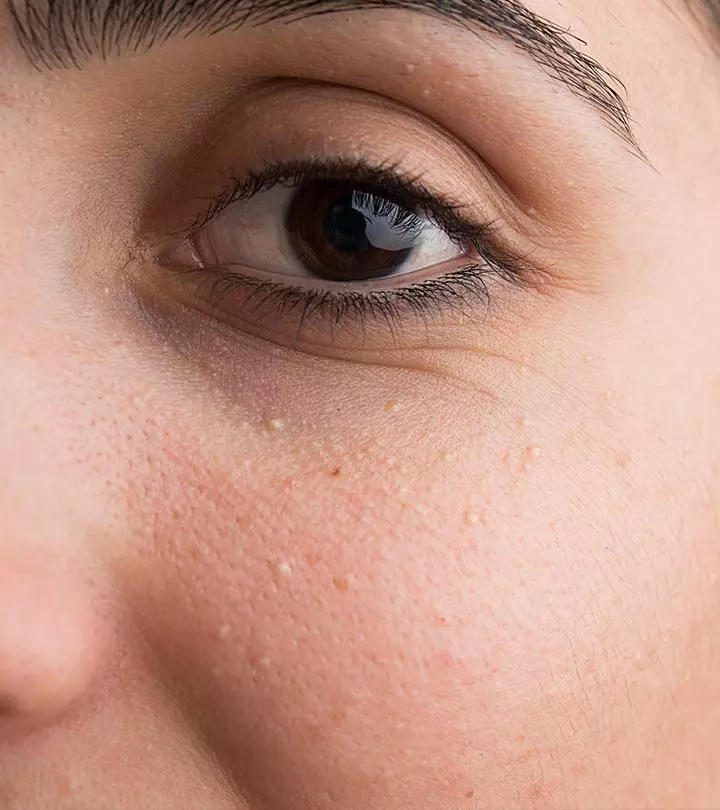
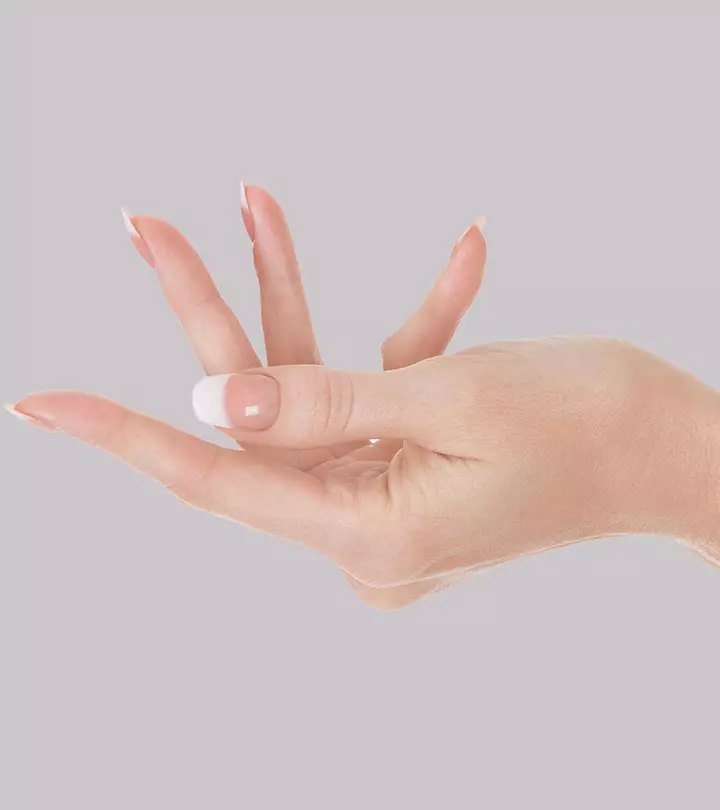

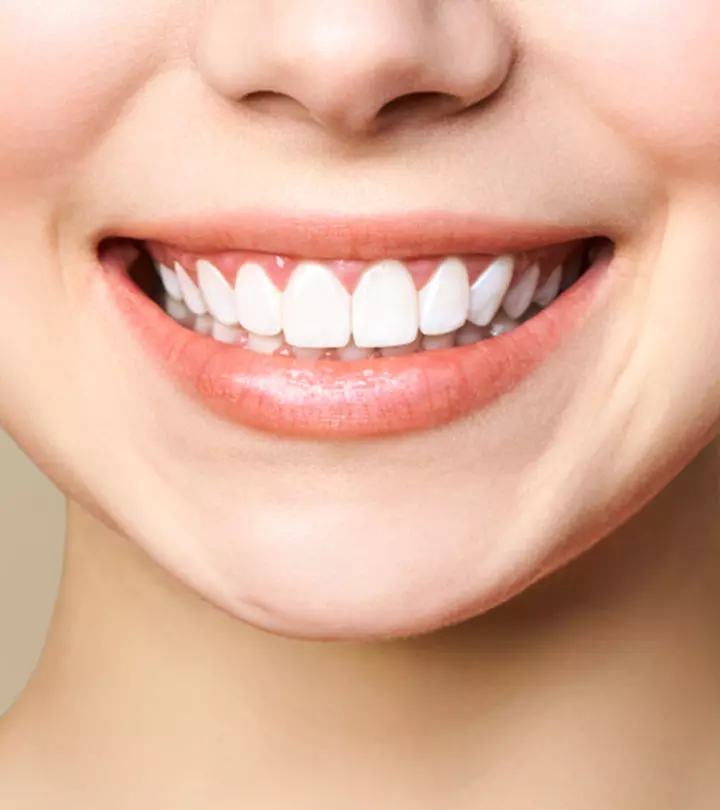


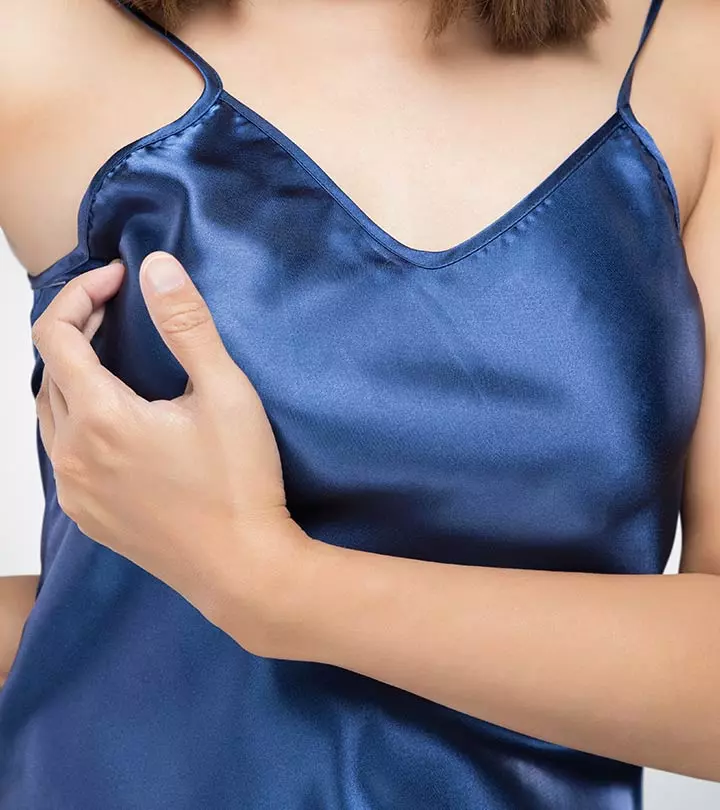
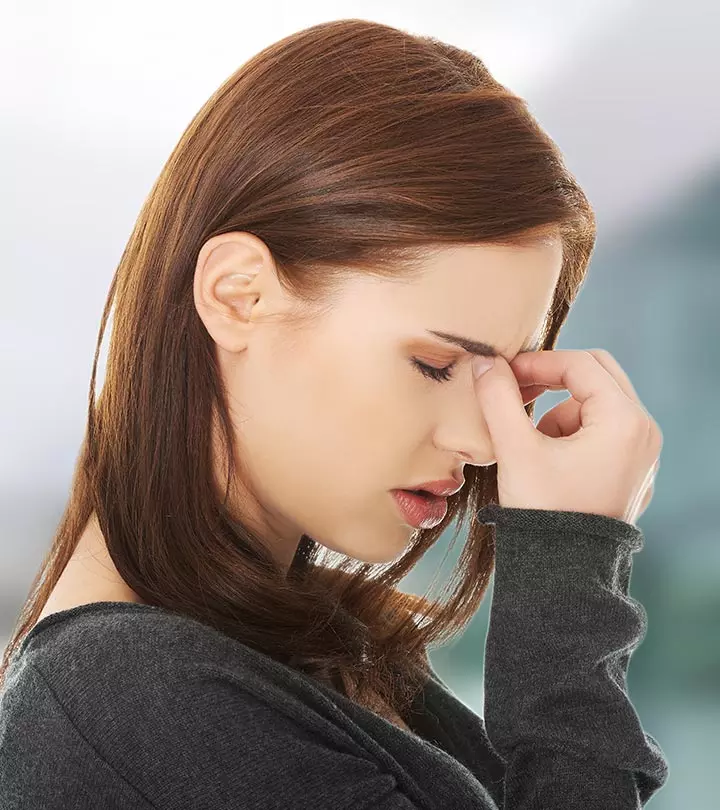
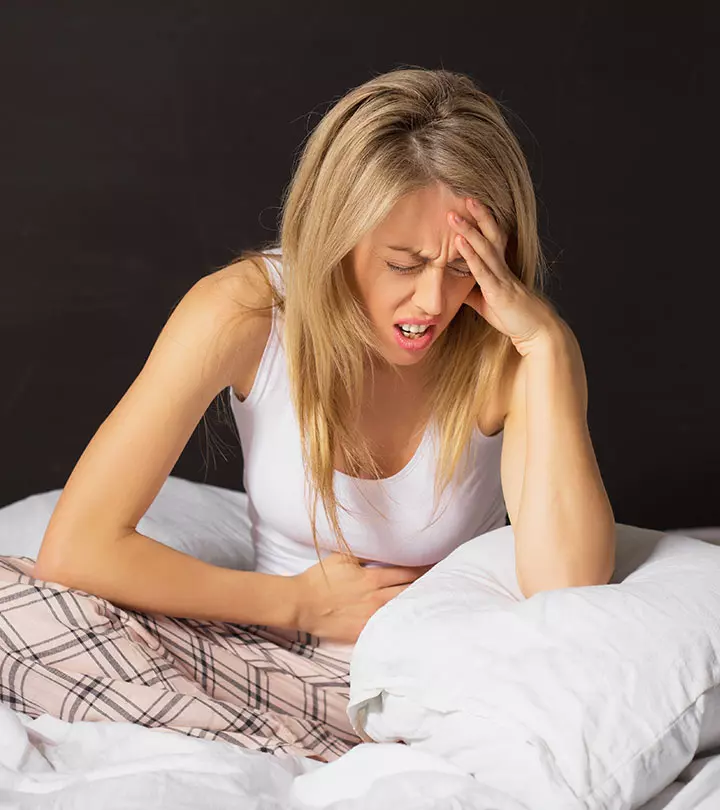
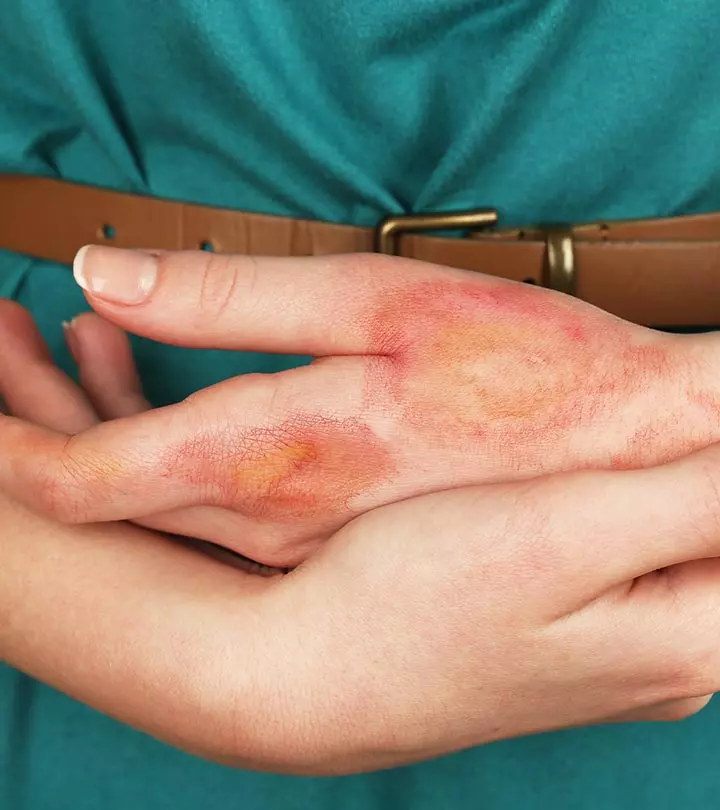
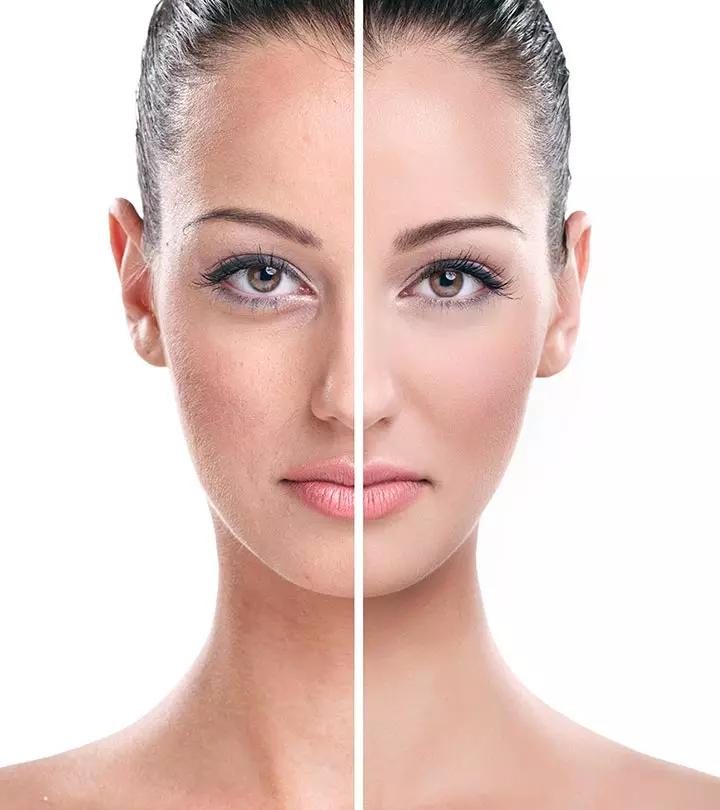
Community Experiences
Join the conversation and become a part of our empowering community! Share your stories, experiences, and insights to connect with other beauty, lifestyle, and health enthusiasts.